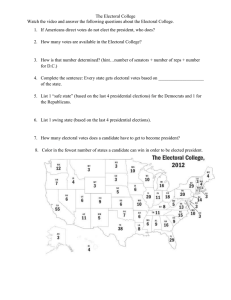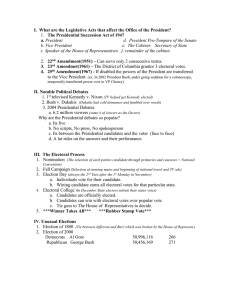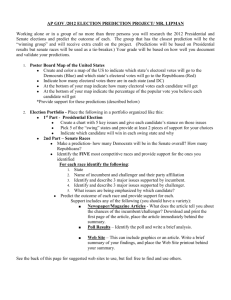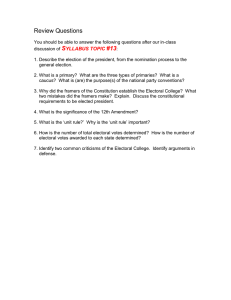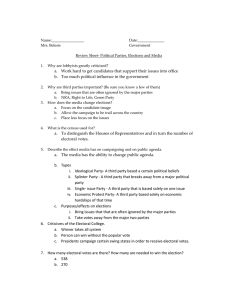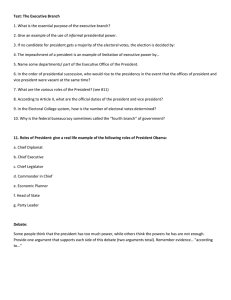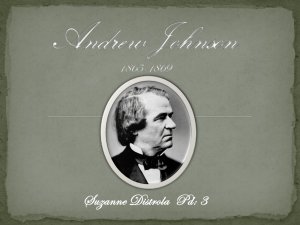41) Which of the following general trends have been revealed... the last three decades?
advertisement
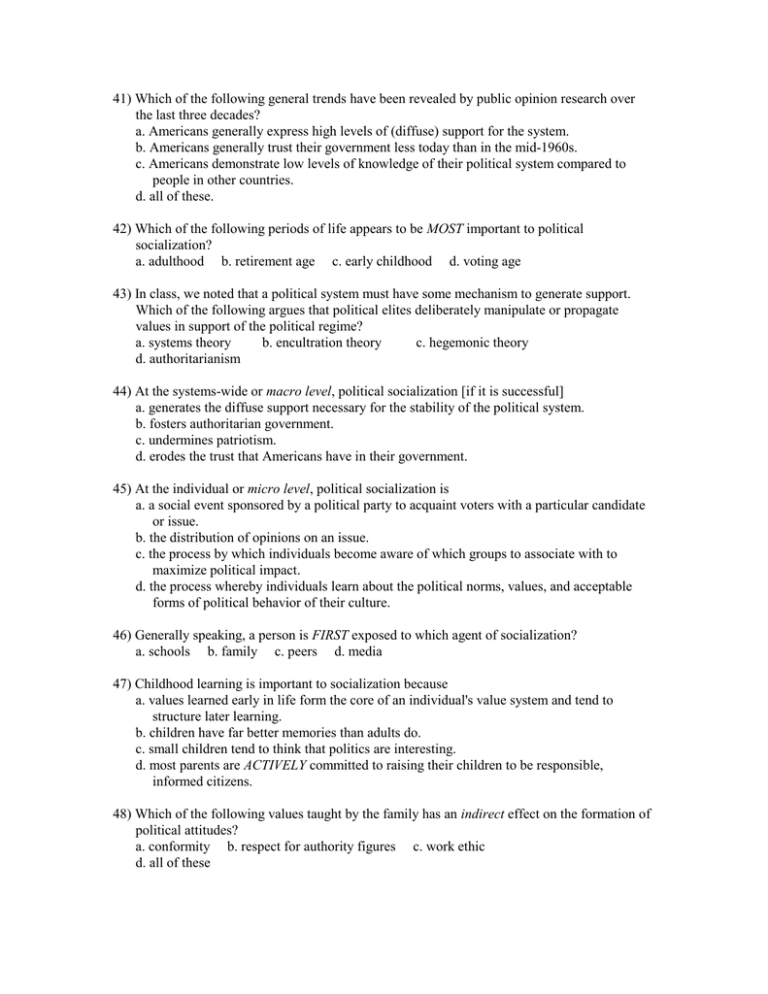
41) Which of the following general trends have been revealed by public opinion research over the last three decades? a. Americans generally express high levels of (diffuse) support for the system. b. Americans generally trust their government less today than in the mid-1960s. c. Americans demonstrate low levels of knowledge of their political system compared to people in other countries. d. all of these. 42) Which of the following periods of life appears to be MOST important to political socialization? a. adulthood b. retirement age c. early childhood d. voting age 43) In class, we noted that a political system must have some mechanism to generate support. Which of the following argues that political elites deliberately manipulate or propagate values in support of the political regime? a. systems theory b. encultration theory c. hegemonic theory d. authoritarianism 44) At the systems-wide or macro level, political socialization [if it is successful] a. generates the diffuse support necessary for the stability of the political system. b. fosters authoritarian government. c. undermines patriotism. d. erodes the trust that Americans have in their government. 45) At the individual or micro level, political socialization is a. a social event sponsored by a political party to acquaint voters with a particular candidate or issue. b. the distribution of opinions on an issue. c. the process by which individuals become aware of which groups to associate with to maximize political impact. d. the process whereby individuals learn about the political norms, values, and acceptable forms of political behavior of their culture. 46) Generally speaking, a person is FIRST exposed to which agent of socialization? a. schools b. family c. peers d. media 47) Childhood learning is important to socialization because a. values learned early in life form the core of an individual's value system and tend to structure later learning. b. children have far better memories than adults do. c. small children tend to think that politics are interesting. d. most parents are ACTIVELY committed to raising their children to be responsible, informed citizens. 48) Which of the following values taught by the family has an indirect effect on the formation of political attitudes? a. conformity b. respect for authority figures c. work ethic d. all of these 49) A child’s party identification is usually consistent with the party identification of a. friends. b. teachers. c. parents. d. figures of authority. 50) A person's sense that what he or she thinks or does will have an impact on what government does is a. political power. b. political efficacy. c. political socialization. d. political participation. 51) In order to win a plurality election, a candidate must a. receive a majority of the popular vote. b. win a run-off election. c. receive more votes than any other candidate does. d. appeal to the most extreme groups. 52) In the United States, what percentage of eligible voters actually casts ballots in presidential elections? a. 33-37% b. 50-54% c. 62-66% d. around 70% 53) In the United States, what percentage of eligible voters actually casts ballots in “off-year” or midterm congressional elections? a. 33-37% b. 50-54% c. 62-66% d. around 70% 54) The major source of political information for the vast majority of citizens is a. newspapers. b. radio. c. television. d. books. 55) Instead of political parties, campaigns are generally directed by the a. individual him/herself. b. party leaders c. professional campaign management firms. d. special interest groups. 56) The principal medium of communication between candidates and voters is a. radio. b. newspaper. c. television. d. debate. 57) Primary elections in which a voter may cast a ballot in either party’s primary election are a. closed primaries. b. open primaries. c. run-off primaries. d. general elections. 58) A person who votes for candidates of different parties for different offices in a general election is called a. maverick. b. absentee voter. c. ticket splitter d. party activist. 59) An electoral system that allocates seats in a legislature based on proportion of votes the parties receive in a national election is a. equal representation. b. bipartisan representation. c. proportional representation. d. disproportionate representation,. 60) Individuals and organizations that contribute to candidate campaigns show a strong preference for a. members of Congress over state legislators. b. incumbents over challengers. c. Republican candidates over Democratic candidates. d. wealthy candidates over financially struggling candidates. 61) It is widely believed that television’s focus on personal character and private lives – rather than on policy positions and governmental experience – encourages a. the high cost of campaigning. b. negative campaigning. c. muckraking coverage. d. campaign exposes. 62) The most expensive aspect of the campaign is a. recruiting talented staff. b. renting centralized office space. c. paying professional staff. d. commercial advertising. 63) Political contributions to a party for activities such as party-building or voter registration, but not directly for campaigns is called a. quiet money. b. soft money. c. party money. d. hush money. 64) PAC contributions go overwhelmingly to a. political challengers. b. party leaders. c. congressional leaders. d. incumbent officeholders. 65) People who perceive the economy as getting worse are likely to vote against the while people who think the economy is getting better support the ___ . a. challenger, incumbent. b. incumbent, challenger. c. challenger, challenger. d. incumbent, incumbent. _____, 66) The Constitution provides that a candidate must receive a majority of Electoral College votes to be elected president. There are a total of 538 electoral votes. How many electoral votes (minimum) must the winning candidate receive? a. 254 b. 270 c. 538 d. at least one more than any other candidate 67) What happens if no presidential candidate receives a majority of the Electoral College vote? a. There is a run-off election. b. The president is elected by the House of Representatives. c. The president is elected by the Senate. d. The entire process must start over, beginning with the nomination of new candidates by the two major parties. 68) In the Electoral College, each state is accorded a number of electoral votes a. equal to the number of the state's senators and representatives in Congress. b. equal to the number of delegates it sends to the national party conventions. c. equal to the number of representatives in the state legislature. d. equal to the number of registered voters in the state. 69) Suppose that in the presidential election in the year 2004, the Republican Party’s candidate gets 20 million popular votes and 241 electoral votes. The Democratic party’s candidate receives 18 million popular votes and 265 votes in the Electoral College. The Green Party’s candidate manages to get 16 million popular votes and 32 votes in the Electoral College. Who becomes president? a. the Republican b. the Democrat c. the Green candidate d. cannot be determined given the above facts. 70) The Electoral College operates according to the "unit rule." The "unit rule" a. is prescribed by the Constitution. b. increases the chances that no candidate will receive a majority of the electoral vote. c. encourages third party candidates. d. means that all of a state's electoral votes go to the candidate who won a plurality of the popular vote. 71) More than influencing policy, political parties are concerned with a. recruiting new members to run for office. b. winning public office in elections. c. soliciting funds from large corporations. d. selecting the site for the next presidential nominating convention. 72) One of the two main parties in American politics which traces its origins to the antislavery and nationalist forces that united in the 1850s is now the a. American-Republican Party. b. Federalist Party. c. Democratic Party d. Republican Party 73) For political parties, winning has generally been more important than a. the high cost of campaigning. b. listening to the requests of party members. c. recruiting new party member. d. any principles or policies. 74) Despite the erosion of many of their functions, American’s political parties survive as the principal institutions for a. running campaigns. b. recruiting candidates. c. organizing elections. d. raising campaign funds. 75) A statement of principles adopted by a political party at its national convention is the a. statement of party procedures b. party’s writ of principles. c. party’s platform. d. party’s planks.
